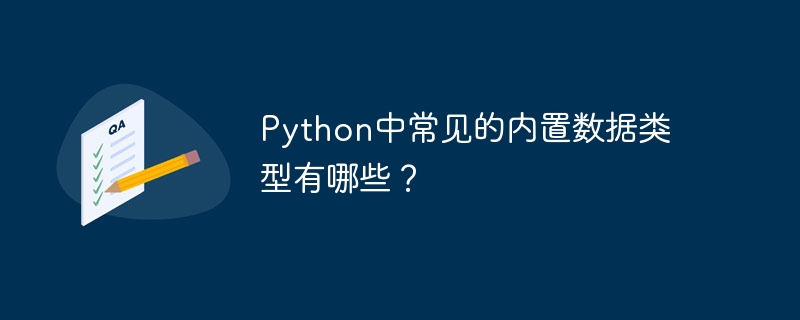
Python has various standard data types that are used to define the operations possible on them and the storage method for each of them.
Python支持四种不同的数值类型 -
int − They are often called just integers or ints, are positive or negative whole numbers with no decimal point.
long − 也称为longs,它们是无限大小的整数,以整数的形式书写,并在后面跟着大写或小写的L。
立即学习“Python免费学习笔记(深入)”;
float − Also called floats, they represent real numbers and are written with a decimal point dividing the integer and fractional parts. Floats may also be in scientific notation, with E or e indicating the power of 10 (2.5e2 = 2.5 x 102 = 250).
complex − 这些是形如 a + bJ 的复数,其中 a 和 b 是浮点数,J(或 j)代表 -1 的平方根(即虚数)。该数的实部是 a,虚部是 b。在Python编程中,复数很少使用。
Let us see an example −
# Python int val1 = 25 print(val1) # Python float val2 = 11.89 print(val2) # Python complex val3 = 6+2.9j print(val3) # Python hexadecimal val4 = 0x12d print(val4) # Python octal val5 = 0o021 print(val5)
25 11.89 (6+2.9j) 301 17
布尔类型有两个值,即True和False。True代表1,False代表0。让我们看一个例子 -
a = (1 == True) b = (1 == False) print(a) print(b)
True False
我们可以通过将字符用引号括起来来轻松创建一个字符串。Python将单引号视为双引号的同义词。创建字符串就像将一个值赋给一个变量一样简单。
Let’s see how to easily create a String in Python −

十天学会易语言图解教程用图解的方式对易语言的使用方法和操作技巧作了生动、系统的讲解。需要的朋友们可以下载看看吧!全书分十章,分十天讲完。 第一章是介绍易语言的安装,以及运行后的界面。同时介绍一个非常简单的小程序,以帮助用户入门学习。最后介绍编程的输入方法,以及一些初学者会遇到的常见问题。第二章将接触一些具体的问题,如怎样编写一个1+2等于几的程序,并了解变量的概念,变量的有效范围,数据类型等知识。其后,您将跟着本书,编写一个自己的MP3播放器,认识窗口、按钮、编辑框三个常用组件。以认识命令及事件子程序。第
 3
3

myStr = Thisisit!'
我们现在将看到一个创建单行和多行字符串的例子 −
str1 = "John" print(str1) # Multi-line string str2 = """ This, is it! """ print(str2)
John This, is it!
A list contains items separated by commas and enclosed within square brackets ([]). Creating a list is as simple as putting different comma-separated values between square brackets. A list can have integer, string or float elements. With that, we can also create a List with mixed data types.
The list can be written as a list of comma-separated values (items) between square brackets. Important thing about a list is that the items in a list need not be of the same type
We will create a list with 10 integer elements and display it. The elements are enclosed by square brackets. With that, we have also displayed the length of the list and how we can access specific elements using the square brackets −
# Create a list with integer elements
mylist = [25, 40, 55, 60, 75, 90, 105, 130, 155, 180];
# Display the list
print("List = ",mylist)
# Display the length of the list
print("Length of the List = ",len(mylist))
# Fetch 1st element
print("1st element = ",mylist[0])
# Fetch last element
print("Last element = ",mylist[-1])
List = [25, 40, 55, 60, 75, 90, 105, 130, 155, 180] Length of the List = 10 1st element = 25 Last element = 180
我们还可以将字符串元素添加到Python列表中。我们将创建一个包含5个字符串元素的列表并显示它。元素被方括号括起来。通过这样做,我们还显示了列表的长度以及如何使用方括号访问第一个和最后一个元素−
# Create a list with string elements
mylist = ["BMW","Audi","Tesla","Honda","Toyota"];
# Display the list
print("List = ",mylist)
# Display the length of the list
print("Length of the List = ",len(mylist))
# Fetch 1st element
print("1st element = ",mylist[0])
# Fetch last element
print("Last element = ",mylist[-1])
List = ['BMW', 'Audi', 'Tesla', 'Honda', 'Toyota'] Length of the List = 5 1st element = BMW Last element = Toyota
元组是一系列不可变的Python对象。元组和列表一样都是序列。元组和列表的主要区别在于元组是不可变的,而列表是可变的。元组使用圆括号,而列表使用方括号。
Let us first create a basic Tuple with integer elements and then move towards Tuples within a Tuple −
# Creating a Tuple
mytuple = (20, 40, 60, 80, 100)
# Displaying the Tuple
print("Tuple = ",mytuple)
# Length of the Tuple
print("Tuple Length= ",len(mytuple))
Tuple = (20, 40, 60, 80, 100) Tuple Length= 5
Python的字典是一种哈希表类型。它们的工作方式类似于Perl中的关联数组或哈希,由键值对组成。创建Python字典的正确语法是以键:值对的形式存储值。冒号的左边存储键,右边存储值,即
key:value
Dictionary is enclosed by curly bracket and do not allow duplicates. According to the 3.7 Python update, dictionaries are now ordered. Consider Dictionary as a set of key: value pairs, with the requirement that the keys are unique (within one dictionary). Each key in a Dictionary is separated from its value by a colon (:), the items are separated by commas, and the whole thing is enclosed in curly braces.
We will create 4 key-value pairs, with keys Product, Model, Units and Available and values Mobile, XUT, 120 and Yes. Keys are on the left of colon, whereas values are on the right −
# Creating a Dictionary with 4 key-value pairs
myprod = {
"Product":"Mobile",
"Model": "XUT",
"Units": 120,
"Available": "Yes"
}
# Displaying the Dictionary
print("Dictionary = \n",myprod)
Dictionary =
{'Product': 'Mobile', 'Model': 'XUT', 'Units': 120, 'Available': 'Yes'}
以上就是Python中常见的内置数据类型有哪些?的详细内容,更多请关注php中文网其它相关文章!

python怎么学习?python怎么入门?python在哪学?python怎么学才快?不用担心,这里为大家提供了python速学教程(入门到精通),有需要的小伙伴保存下载就能学习啦!

Copyright 2014-2025 https://www.php.cn/ All Rights Reserved | php.cn | 湘ICP备2023035733号